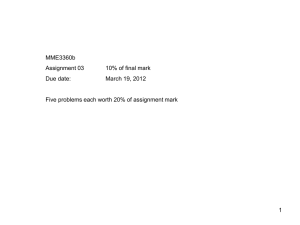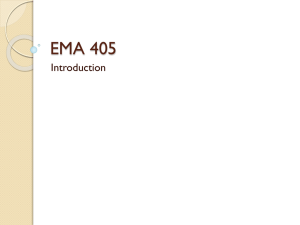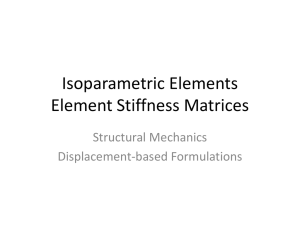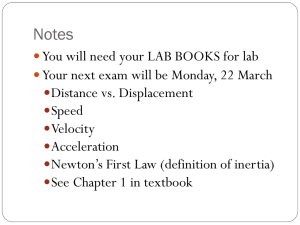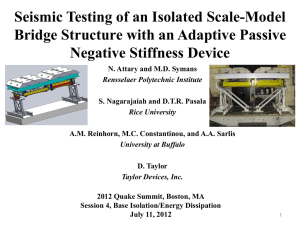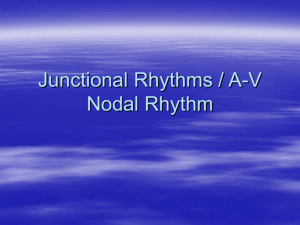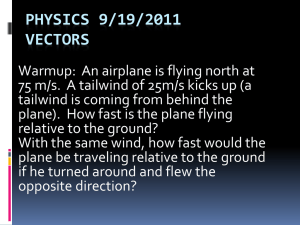Document
advertisement
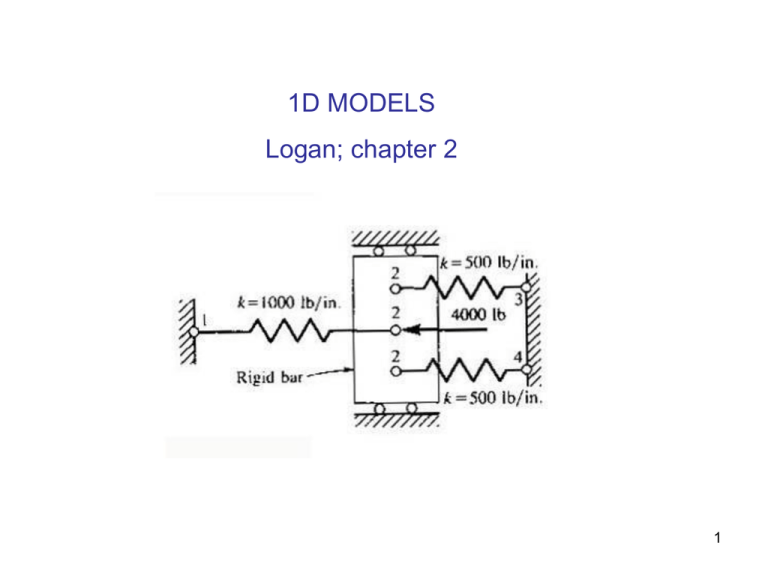
1D MODELS Logan; chapter 2 1 DEFINITION OF SPRING ELEMENT k What is the relation between forces acting on spring ends and displacements of these ends? Or, using FEA terminology, what is the relation between nodal displacements and forces acting on these nodes? To formulate this relation we must first assume displacement pattern in-between nodes. Let’s assume linear displacement: We assume linear displacement along the length of element. This is our displacement interpolation function. 0≤x≤L The displacement function has as many coefficients as the element has degrees of freedom, in this case 2 2 DEFINITION OF SPRING ELEMENT We now want to express displacement u along the element as a function of nodal displacements This is the relation between nodal displacements and displacements along the length of elements (i.e. in-between nodes) 3 DEFINITION OF SPRING ELEMENT The same can be written in matrix form: where are called shape functions 4 DEFINITION OF SPRING ELEMENT k Let’s say that element experiences force T This force causes nodal displacements and Relation between force and nodal displacements Force acting on node 1 Force acting on node 2 This matrix relates nodal displacements of spring element to forces acting on nodes of that element. This matrix is called element stiffness matrix 5 DEFINITION OF SPRING ELEMENT Element stiffness matrix describes relation between nodal loads and nodal displacement of an element. This is matrix is: Square Symmetric Singular (determinant equals zero) Positive Diagonal Terms 6 ONE SPRING THIS IS CALLED A BAR ELEMENT 1 . 2 . F2 Find displacements of point 2; find reactions in point 1 when force F2 is acting on node 2 This problem lends itself well toward discretization with one spring element: 1 . 2 . 0 F2 F Reaction F2 7 TWO SPRINGS IN SERIES k1 1 . k2 . 3 2 . F3 Find displacements of point 3; find reactions in points 1 and 2 This problem lends itself well toward discretization with two spring elements: Solution steps 1. Formulate stiffness matrix for individual elements 2. Expand individual stiffness matrices so that they are associated with all degrees of freedom in the system 3. Assemble global stiffness matrix 4. Solve for displacements and reaction forces 8 TWO SPRINGS IN SERIES Relation between nodal displacements and forces in element 1 Relation between nodal displacements and forces in element 2 or 9 TWO SPRINGS IN SERIES Relation between nodal displacements and forces in element 1int he expanded form expanded Relation between nodal displacements and forces in element 2 in the expanded form expanded 10 TWO SPRINGS IN SERIES Expanded matrices of elements 1 and 2 can now be added to form the global stiffness matrix Relation between nodal displacements and nodal forces has been formed: Global stiffness matrix Vector of nodal displacements Vector of nodal loads These matrixes been expanded before global stiffness matrix could be assembled. The process in which individual matrices are expanded and then added to form global stiffness matrix is called Direct Stiffness Method also known as the displacement method or matrix stiffness method 11 TWO SPRINGS IN SERIES The process in which individual matrices are expanded and then added to form global stiffness matrix is called Direct Stiffness Method also known as the displacement method or matrix stiffness method 12 TWO SPRINGS IN SERIES In our case node 1 and node 2 are fixed: This is A set of three equations with three unknowns: d3, F1, F2 13 THREE SPRINGS IN SERIES k1 1 . k2 . 3 F1 k3 4 . 2 . F2 Find displacements of points 3 and 4; find reactions in points 1 and 2. This problem lends itself well toward discretization with three spring elements. Solution steps 1. Formulate stiffness matrix for individual elements 2. Expand individual stiffness matrices so that they are associated with all degrees of freedom in the system 3. Assemble global stiffness matrix 4. Solve for displacements and reaction forces 14 THREE SPRINGS IN SERIES Note that: Therefore these matrixes must be expanded before global stiffness matrix can be assembled. 15 THREE SPRINGS IN SERIES Stiffness matrix of element 1 before expansion k1 1 And after expansion . k2 . 3 F1 k3 4 . 2 . F2 16 THREE SPRINGS IN SERIES Stiffness matrix of element 2 before expansion k1 1 And after expansion . k2 . 3 F1 k3 4 . 2 . F2 17 THREE SPRINGS IN SERIES Stiffness matrix of element 3 before expansionk k2 1 1 And after expansion . . 3 F1 k3 4 . 2 . F2 18 THREE SPRINGS IN SERIES Stiffness matrices can now be added to assemble global stiffness matrix Therefore, the relation between all nodal displacements and all nodal forces is: Vector of nodal loads Global stiffness matrix Vector of nodal displacements 19 THREE SPRINGS IN SERIES Known nodal displacements (displacements boundary conditions): d1=0 d2=0 Known nodal loads (force boundary conditions): f3 = - F1 f4 = F2 This is a set of four linear algebraic equations with fours unknowns: d3, d4 nodal displacements f1, f3 reaction forces 20 THREE SPRINGS IN SERIES/PARALLEL Before expansion: Element 1 Element 2 Element 3 21 THREE SPRINGS IN SERIES/PARALLEL And after expansion 22 STIFFNESS MATRIX CHARACTERISTICS Symmetric This means that kij = kji. This is always the case when the displacements are directly proportional to the applied loads. Square The number of rows are equal to the number of columns in the matrix. Singular The element stiffness matrix is singular (the determinate of the matrix is equal to zero) since no constraints (prescribed displacements and/or rotation) have been applied. Positive Diagonal Terms All the terms in the main diagonal (upper left to lower right) must be positive. If k ii is negative then the force and it's corresponding displacement would be oppositely directed, which is physically unreasonable. If kii = 0, then the displacement would produce no reaction force resisting it, which would imply that the structure is unstable. 23 WHY IS STIFFNESS MATRIX SYMMETRIC? BETTI’S THEOREM* (RECIPROCITY THEOREM) Betti’s theorem, discovered by Enrico Betti in 1872 states that for all linear elastic structures subject to two sets of forces Pi and Qi, the work done by the set P though the displacement produced by set Q is equal to the work done be the set Q through displacements produced by set P. *A theorem is a statement which has been proved on the basis of previously established statements, such as other theorems, and previously accepted statements, such as axioms 24 WHY IS STIFFNESS MATRIX SYMMETRIC? Betti’s theorem example Consider a beam on which two points 1 and 2 have been defined. First we apply force P at point 1 and measure the vertical displacement of point 2. Then we remove force P and apply force Q at point 2. Betti’s reciprocity theorem states that: PQ1 QP2 Q P 1 2 ΔP1 ΔQ1 25 WHY IS STIFFNESS MATRIX SQUARE? Number of unknowns equals the number of equations 26 WHY IS STIFFNESS MATRIX SINGULAR? Displacement boundary conditions have not yet been defined 27 WHY ARE ALL TERMS ON THE MAIN DIAGONAL MUST BE POSITIVE? Negative terms would indicate negative stiffness. Zero terms would indicate no stiffness in given direction. 28 1 1 Sequential numbering 2 3 2 3 4 4 5 Element stiffness k=10N/mm Bandwidth = 3 29 1 1 Out of sequence numbering 2 3 5 3 4 4 2 Element stiffness k=10N/mm Bandwidth = 5 30
